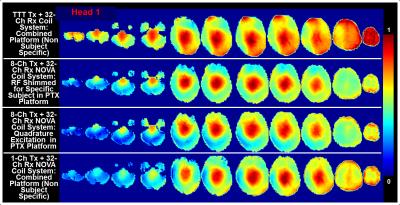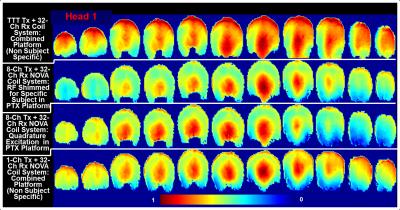4403
Towards Homogeneous 7T Neuro Imaging: Findings and Comparisons between 7T TTT and NOVA RF Coil Systems1Bioengineering, University of Pittsburgh, Pittsburgh, PA, United States, 2Radiology, University of Pittsburgh, Pittsburgh, PA, United States, 3Bioengineering, University of Pittsburgh, Cranberry Twp, PA, United States, 4Radiology, University of Minnesota, Minneapolis, MN, United States, 5Psychiatry, University of Pittsburgh, Pittsburgh, PA, United States, 6Siemens Medical Solutions, United States
Synopsis
Several major obstacles still face neuro UHF imaging including scanning and preparation time for every subject (for TX arrays) and RF intensity limitations due to increased local/global power deposition. The solutions provided and compared in this work represent non-subject specific configurations (combined mode NOVA coil system, PTX NOVA coil system operating in quadrature, and combined mode 16Tx/32Rx Tic-Tac-Toe coil system) and subject specific configurations (PTX NOVA coil system RF-shimmed for each subject). Experimental results shows significant drop in the B1+ field intensity in the left temporal lobe and cerebellum in the NOVA coil systems, issue alleviated with the Tic-Tac-Toe design.
Purpose
The use of Tx arrays at 7T is common for alleviating RF inhomogeneities and addressing RF safety concerns. Several major obstacles still face neuro UHF imaging/spectroscopy such as considerable scanning and preparation time for every subject; significant RF excitation (B1+ field) intensity losses due to increased local/global power deposition in tissue at lower flip angles; and concerns regarding the unclear RF safety assurance between different subjects. The solutions provided and compared in this work represent non-subject specific configurations (combined mode 7T 1Tx + 32Rx NOVA coil system [Nova Medical, Inc., Wilmington MA], PTX mode 8Tx + 32Rx NOVA coil system [Nova Medical, Inc.] operating in quadrature [CP], and combined mode 16Tx + 32Rx Tic Tac Toe (TTT) coil system operating with one generic RF shim set) and subject specific configurations (PTX mode 8Tx + 32Rx NOVA coil system that is RF-shimmed for each subject).Methods
The 16Tx + 32Rx TTT coil system (earlier versions [4 Tx Chs.] for various applications were shown in (1-3)) is composed of 4-Z rows of 4-coil elements resulting 16 Tx channels which are tied in a specific configuration in order to produce 8 Tx elements that can be connected directly to a PTX system (if PTX Mode is utilized) or to an 8-way Wilkinson splitter/combiner (if the combined mode is utilized). The Rx only insert is a helmet style array with 32-chs. The coil does not utilize subject-specific RF shimming and one RF shim set it utilized in all studies. The following issues were investigated for the TTT coil system: performance parameters such B1+ homogeneity/intensity/coverage, peak/global SAR, and repeatability across different subjects; methodology of operation including applicability and performance within several patient/disease studies (n > 100); and highly detailed comparisons with gold standard coil/array designs NOVA coil systems.
All the experimental data were carried out using a 7T MAGNETOM® system equipped with PTX array capability (Siemens Medical Solutions, Erlangen, Germany). Simulations were done using in-house finite difference time domain (FDTD) package. Experimental RF field mapping was performed using SAT Turbo Flash sequence with the following parameters: FOV: 64 x 64 mm2; TE: 1.16 ms; TR: 2000 ms; FA: 6⁰; BW: 1502 MHz; Resolution: 3.125 x 3.125 x 2.0 mm3; and 6 flip angles. Axial TSE images were acquired with following parameters: 0.4x0.4x2mm; GRAPPA2; TR/TE=8500/54ms. Axial FLAIR images were acquired with following parameters: 0.7 x 0.7 x 2mm2; GRAPPA2; TR/TE/TI=13500/103/2900ms.
Results and Discussion
The TTT design is capable of achieving excellent coverage and homogeneity (FDTD simulations show an average and continuous B1+ intensity of 2 microtesla is achieved with average SAR~1.8-1.9 and coefficient of variation = ~ 17.5% and maximum B1+ field intensity/minimum B1+ field intensity = 3.2 for the whole head (excluding the nasal cavity) above and including the cerebellum).
Figures 1-3 show qualitative comparisons (measured axial/sagittal/coronal B1+ field distributions in vivo) between the TTT coil system and the combined-mode and PTX-mode NOVA coil systems (in Head 1). Figure 4 shows quantitative experimental analysis (measured B1+ field in vivo) for both Head 1 and Head 2. On an average (see Figure 4), the coefficient of variation of measured B1+ field in vivo was ~ 21% for the TTT design (with one RF shim set used for both Head1 and Head2), while it ranged between ~24% and 31% for the NOVA coils systems (depending on the head, the coil type or the RF shimming type). Average B1+ intensity over Whole Head 1 is ~ 22.5% lower (for the same input voltage) with the TTT design when compared to the most efficient (Combined Mode) NOVA coil design (note that NOVA SAR simulations are not currently available to our lab at this time). The average B1+ intensity over Whole Head 2 is ~ 31.5% lower (for the same input voltage) with the TTT design when compared to the (Combined Mode) NOVA coil. Note that Average B1+ intensities over Whole Head 2 & Whole Head 1 per same input voltage are within 1.5 % (2.5% for RF power) for the TTT design but differ by 9.5% (20% for power) for the NOVA coil. Figure 5 shows the TSE and FLAIR images for both coil systems o Head1, Head2 and Head3. Matching the experimentally measured B1+ field findings, the combined mode NOVA coil system exhibits significant drop in the B1+ field intensity in the left temporal lobe and cerebellum. This issue is alleviated with the TTT design.
Acknowledgements
The work of this abstract is partially supported by NIH.
References
1. Zhao Y, Zhao T, Raval SB, Krishnamurthy N, Zheng H, Harris CT, Handler WB, Chronik BA, Ibrahim TS. Dual optimization method of radiofrequency and quasistatic field simulations for reduction of eddy currents generated on 7T radiofrequency coil shielding. Magn Reson Med. 2014. Epub 2014/11/05. doi: 10.1002/mrm.25424. PubMed PMID: 25367703; PMCID: 4515214.
2. Kim J, Krishnamurthy N, Santini T, Zhao Y, Zhao T, Bae KT, Ibrahim TS. Experimental and numerical analysis of B1+ field and SAR with a new transmit array design for 7T breast MRI. Journal of Magnetic Resonance. doi: http://dx.doi.org/10.1016/j.jmr.2016.04.012.
3. Kim J, Krishnamurthy N, Santini T, Zhao Y, Zhao T, Bae KT, Ibrahim TS. Experimental and numerical analysis of B1+ field and SAR with a new transmit array design for 7T breast MRI. J Magn Reson. 2016;269:55-64. Epub 2016/05/31. doi: 10.1016/j.jmr.2016.04.012. PubMed PMID: 27240143.
Figures




